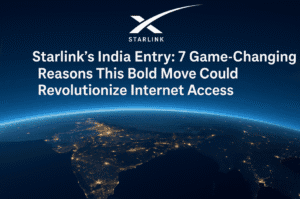Starlink’s India Entry: 7 Game-Changing Reasons This Bold Move Could Revolutionize Internet Access
Elon Musk’s Starlink has secured Indian regulatory approval after a three-year wait, marking a breakthrough in its global expansion. The green light follows high-level talks between PM Modi and Musk, emphasizing tech collaboration, and aligns with India’s push to diversify connectivity solutions. Starlink overcame fierce opposition from telecom giants Reliance Jio and Bharti Airtel, which advocated auctioning satellite spectrum, but the government opted for administrative allocation, favoring shared spectrum practicality. To penetrate the market, Starlink forged retail partnerships with Jio and Airtel, targeting urban users despite premium pricing.
India’s approval mandates strict guidelines: 20% local manufacturing of ground infrastructure within five years, integration of India’s NavIC navigation system by 2029, and data storage within borders to ensure sovereignty. While the service promises to bridge connectivity gaps in remote areas, affordability and monsoon-related disruptions pose challenges. This move positions India as a testing ground for balancing innovation with self-reliance, setting a precedent for global satellite internet markets.

Starlink’s India Entry: 7 Game-Changing Reasons This Bold Move Could Revolutionize Internet Access
Elon Musk’s Starlink has finally secured regulatory approval to operate in India, marking a pivotal moment in the country’s digital evolution. After a three-year wait, the company’s clearance to offer satellite-based internet services could reshape connectivity landscapes, intensify market competition, and test India’s balancing act between innovation and self-reliance.
A Long-Awaited Green Light
Starlink’s journey to approval involved rigorous national security evaluations and high-stakes discussions with Indian authorities. The company’s persistence paid off when it received a critical Global Mobile Personal Communication by Satellite (GMPCS) license, following a letter of intent from the government. This milestone aligns with Prime Minister Narendra Modi’s recent dialogue with Musk, emphasizing tech collaboration, and Starlink’s strategic meetings with Commerce Minister Piyush Goyal to fast-track approvals.
Spectrum Wars: Administrative Allocation Wins
The approval process wasn’t without friction. Starlink clashed with telecom giants Reliance Jio and Bharti Airtel over spectrum allocation methods. While Jio advocated for auctions—a model familiar to terrestrial networks—Starlink pushed for administrative allocation, arguing that satellite spectrum is shared and technically challenging to auction. The government’s decision to side with administrative allocation reflects global precedents and acknowledges the unique demands of satellite technology. This move could lower entry barriers for niche players while ensuring efficient spectrum use.
Partnerships to Penetrate the Market
Despite competing with Jio and Airtel in broadband services, Starlink has shrewdly partnered with both telecom leaders to leverage their retail networks. These collaborations aim to integrate satellite internet into existing offerings, targeting affluent urban households initially. However, analysts note that Starlink’s higher costs (compared to traditional broadband) may limit rural adoption unless subsidized by government initiatives like the Universal Service Obligation Fund.
Regulatory Strings Attached
India’s approval comes with stringent guidelines to align Starlink’s operations with national priorities:
- Local Manufacturing: A phased plan mandates 20% indigenization of ground infrastructure within five years, supporting Modi’s Atmanirbhar Bharat (self-reliant India) vision.
- Data Sovereignty: Real-time traffic monitoring and in-country data storage ensure user data remains within borders, addressing security concerns.
- NavIC Integration: By 2029, Starlink must incorporate India’s homegrown NavIC navigation system, reducing reliance on foreign GPS and boosting local tech ecosystems.
- Security Protocols: Mechanisms to block services during emergencies and cooperate with law enforcement underscore the government’s focus on cyber resilience.
Market Dynamics and Challenges
Starlink’s entry disrupts a market dominated by Jio and Airtel, introducing satellite internet as a premium alternative. While its low-latency, high-speed services could revolutionize sectors like telehealth, education, and disaster management, challenges persist:
- Affordability: With user terminals costing ~₹30,000 and monthly fees upwards of ₹1,500, adoption may be slow outside urban elites.
- Technical Hurdles: Monsoon weather and infrastructure gaps could affect service reliability.
- Regulatory Compliance: Meeting manufacturing and NavIC deadlines will test Starlink’s adaptability.
The Road Ahead
Starlink’s approval signals India’s openness to cutting-edge tech while safeguarding strategic interests. For consumers, it promises faster internet in underserved regions, though scalability hinges on cost reduction. For competitors, it’s a wake-up call to innovate or collaborate. Globally, India’s model—blending foreign investment with domestic mandates—could inspire emerging economies navigating the satellite internet boom.
As India strides toward its Digital India goals, Starlink’s success will depend on balancing ambition with accessibility, proving that satellite internet isn’t just a luxury for the few but a bridge to inclusion for the many.
You must be logged in to post a comment.